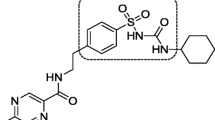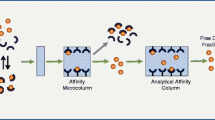Abstract
Purpose. The purpose of this study was to investigate the binding mechanism of aldosterone antagonist diuretics with human serum proteins, human serum albumin (HSA) and α1-acid glycoprotein (AGP), as well as to identify the binding sites of the drugs on these proteins.
Methods. Binding activities of spironolactone (SP) and its pharmacologically active metabolite canrenone (CR) to serum and serum protein were examined by ultrafiltration and spectroscopic techniques. The data for the binding of these drugs to HSA were analyzed on the basis of a theoretical model of simultaneous binding of the ligands.
Results. The binding percentages of antagonist diuretics SP and CR to human serum proteins were 88.0% and 99.2%, respectively, at therapeutic concentrations. SP bound strongly and almost equally to both HSA and AGP, but CR bound strongly only to HSA. In addition, the displacement results found using fluorescent probes and ultrafiltration methods demonstrated that SP bound to site I, particularly to the warfarin region on HSA, and to the basic binding site on AGP, while CR bound to the warfarin region on HSA.
Conclusions. The limited results presented here stress the need for caution on coadministration of acidic drugs which bind to the warfarin region on HSA and basic drugs which bind to AGP with SP and its metabolite CR.
Similar content being viewed by others
REFERENCES
W. P. M. H. Overdiek, W. A. J. J. Hermens, and F. W. H. M. Merkus. New insights into the pharmacokinetics of spironolactone. Clin. Pharmacol. 38:469–474 (1985).
G. Sudlow, D. J. Birkett, and D. N. Wade. Further characterization of two specific binding sites on human serum albumin. Mol. Pharmacol. 12:1052–1061 (1976).
G. Scatchard. Attractions of proteins for small molecules and ions. Ann. NY. Acad. Sci. 51:660–672 (1949).
K. Yamaoka, Y. Tanigawara, T. Nakagawa, and T. Uno. A pharmacokinetic analysis program (MULTI) for microcomputer. J. Pharmacobio-Dyn. 4:879–885 (1981).
U. Kragh-Hansen. Molecular aspects of ligand binding to serum albumin. Pharmacol. Rev. 33:17–53 (1981).
M. O. Decroix, R. Zini, J. C. Chaumeil, and J. P. Tillement. Cefazolin serum protein binding and its inhibition by billirubin, fatty acids and other drugs. Biochem. Pharmacol. 37:2807–2814 (1988).
S. N. Anthony, B. K. Ronald, and W. N. David. Distribution coefficients and in vitro human serum protein binding of spironolactone and its 7α-carboxymethyl analog. J. Pharm. Sci. 69:30–32 (1980).
K. J. Fehske, W. E. Muller, and U. Wollert. The location of drug binding sites in human serum albumin. Biochem. Pharmacol. 30:687–692 (1981).
K. Yamasaki, T. Maruyama, U. Kragh-Hansen, and M. Otagiri. Characterization of site I on human serum albumin: concept about the structure of a drug binding site. Biochim. Biophys. Acta 1295:147–157 (1996).
Author information
Authors and Affiliations
Corresponding author
Rights and permissions
About this article
Cite this article
Takamura, N., Maruyama, T., Ahmed, S. et al. Interactions of Aldosterone Antagonist Diuretics with Human Serum Proteins. Pharm Res 14, 522–526 (1997). https://doi.org/10.1023/A:1012168020545
Issue Date:
DOI: https://doi.org/10.1023/A:1012168020545




